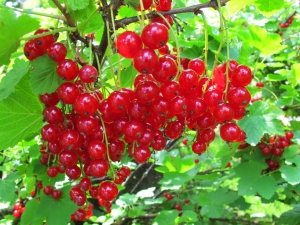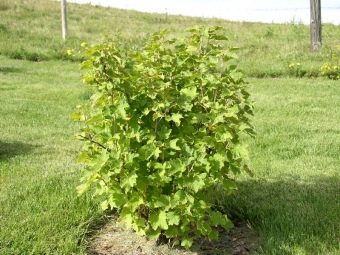Characteristics currant "Dutch"

Useful properties of currants are known for a long time, therefore this plant can be found on almost every summer cottage.There are many types of currants, but among gardeners the old West European variety, which is called “Dutch”, is especially popular. He received a lot of positive feedback due to simple berries care and an abundance of fruits.
Variety description
Currant "Dutch" is different: pink, red and white. Each of these varieties is characterized by its own characteristics. “Dutch pink” refers to late ripening and grows in the form of medium-sized bushes, the height of which does not exceed 1.5 m. Since the plant is not thick and developmental, the fruits ripen quickly and evenly. Its berries are large-fruited and reach up to 1.1 g, but if you ensure proper care, you can get berries weighing up to 2.5 g as a reward. Currant fruits have small seeds inside and are externally covered with thin skin, which makes them distinctive from ordinary varieties .
The main advantage of this plant is that it is resistant to temperature changes, is not afraid of frost in winter and withstands drought in summer. In addition, the culture is not exposed to pests and diseases. Since this variety is high-yielding, up to 9 kg of berries can be harvested from one adult bush. Its only downside is late fruiting.
Well-proven among gardeners and currants "Dutch white". It forms a small and modest-sized shrub that is unpretentious in maintenance, but not suitable for planting in all areas. To get a high yield and large berries, the plant must be grown in areas with moisture and minerals. This culture is self-fertile and easily propagated by green or ligneous cuttings. Despite the fact that the variety is fruitful, it is unstable to the disease anthracnose, therefore, plantings should be periodically treated with special preparations.
White currant begins to bear fruit in the third year after disembarkation and to bring a high harvest of berries in the sixth year, while it is worth noting that the fruit is produced annually. In the presence of normal conditions for growth and formation from one bush it is possible to collect up to 9 kg of berries, which ripen early and can hang on the bushes for a long time without falling off. Berry picking is usually carried out in one step. During the laying of buds on the bushes, it is important to provide the plant with additional feeding.
The berries of white currant are rounded or slightly flattened along the poles with a characteristic delicate cream shade. The peel of the fruit is transparent and thin, within them are clearly visible seeds, the locations of which are displayed on the surface in the form of veins. Since the pulp of the berries is juicy with a pleasant combination of sweetness and acid, they are often used for different types of harvesting.
As for the Dutch Red currant, it is characterized by a high content of not only vitamins, but also pectins, which help cleanse the human body of harmful substances and stop the development of tumors and inflammatory processes. The bush is vigorous, at the first stage of development it is straight, then it becomes thick. The shoots of the plant are also straight and thick, gray-brown in color. On each stem of the currant are formed single, oblong buds with a slightly pointed tip. The berries are red, sweet-sour in taste, their maximum mass can reach 1 g.
The variety “Dutch Red” is self-fruited and frost-resistant, up to 5 kg of fruits can be harvested from one bush. They have a rounded shape, although sometimes they are also flattened along the poles. The only disadvantage of this currant is that its berries with hard and large seeds. In addition, this variety is of late ripening. Despite the variety of varieties "Dutch", all its varieties have only positive reviews.
Therefore, if there is a desire to constantly provide family members with useful microelements, then it is necessary to plant several currant bushes in the summer cottage.
Features of planting and care
"Dutch" currant is considered an unpretentious plant, with the care of which even a novice gardener will be able to cope.
To ensure the bushes all the necessary conditions for growth and formation, and at the end of the season to get a wonderful harvest, it is worth considering the following nuances.
- This variety belongs to the light-loving, so the plant requires a well-lit place for planting. If the bushes are placed in darkened areas of the site, it is possible to reduce the fruiting, the berries will lose their sugar content. It is recommended to plant currants near small hedges or fences, this will protect it from the wind.
- Watering the bushes should be carried out moderately, as they do not tolerate excess moisture. In the case where the site is located in areas where there is a frequent likelihood of flooding, then special drainage must be done, otherwise the shrub will weaken, lag behind in growth and be able to die. This also applies to soil structure, currants prefer to grow on slightly acidic soils.
- Watering is desirable to carry out several times a week, at the rate of one bucket of water per bush, "water procedures" are allowed both in the morning and in the evening. Moisture is especially important for currants from the beginning of July until the end of August, when inflorescences are laid and fruits are formed, with its shortage, yield losses are possible both in the current and in the next season.
- During the planting of seedlings they should be deepened into the ground by 5-10 cm.
- The young seedling of the plant needs pruning of the branches, they are removed by half or 2/3. In addition, to increase the yield and increase the taste of berries in one area, it is best to plant several different varieties that can independently pereopylyatsya. An area of 2 m2 should be allocated to one bush, and the distance between seedlings should be 1–1.5 m.
- "Dutch" currant needs feeding, it is carried out when planting, introducing organic solutions based on humus and humus. Then, when the seedling has taken root, it can be fed with superphosphate, wood ash and potassium sulfate. In addition, in order to protect the winter, shrubs can be poured with horse humus, it will not only feed the soil gradually, but also protect the plant from snow-free winters and frosts.
- An important point in the care of the "Dutch" currant, whether it is pink, red or white, is considered the correct pruning, which will directly depend on disease resistance and the level of yield. During planting, to speed up the formation of branches, young seedlings are cut in half, then pruning is carried out in early spring before the buds are blossomed and late in the autumn after picking the fruits. Branches should be shortened carefully, trying not to leave the "hemp", while on the old bushes, where there are dry shoots, they are completely stripped.
- If the currant bush is too branched, and its lower shoots with fruits fall on the ground, they must also be removed. Periodic thinning of the stems has a beneficial effect on the development of the bushes, preventing their diseases and increasing fruiting. In young seedlings, as a rule, they leave several straight and strong shoots, while the rest are curves and weak ones are cut. To facilitate the pruning process, this procedure is recommended to be carried out regularly throughout the year, since a one-time full trimming will be a “shock” for a bush that may die. It is desirable that on one bush the number of branches does not exceed 15-20.
Following these simple guidelines, every amateur gardener will manage to grow chic currant bushes of the Dutch variety. The main thing - to buy quality seedlings and not be too lazy to care for them. Then at the end of the year gardeners will receive an excellent reward - a high yield of medicinal berries.
You will learn more about the Dutch currant variety in the following video.





































